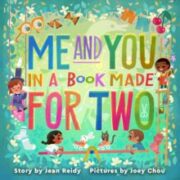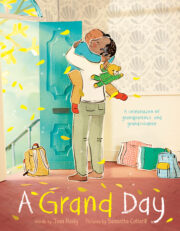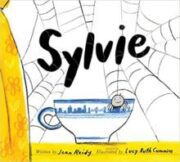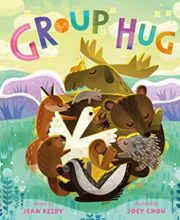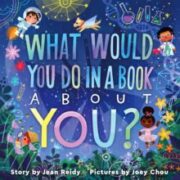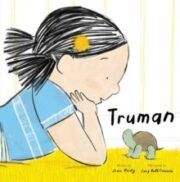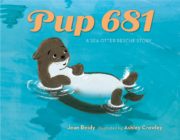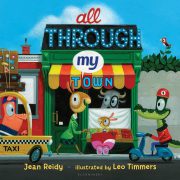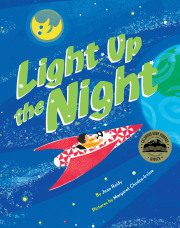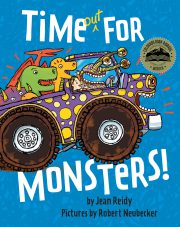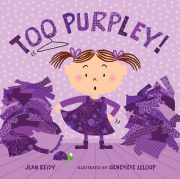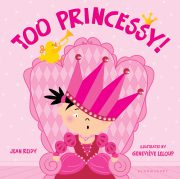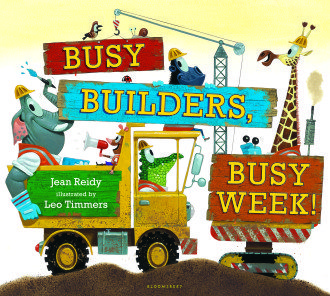 Welcome, friends!
Welcome, friends!
My latest picture book, BUSY BUILDERS, BUSY WEEK! is out in the world. YIPPEE!
In this story, you’ll meet a colorful cast of animal characters building something wonderful and whimsical for their community! Each day of the week features a different construction activity as the digging, dumping and ‘dozing lead up to one stupendous surprise!
Here’s what Publishers Weekly had to say-
“In this bouncy story from the creators of ALL THROUGH MY TOWN, an energetic animal construction crew plans and executes a mystery project over the course of a single week. The result is a joyful cacophony of color and activity.”
Joyful cacophony, indeed!
So, it seemed only fitting that for a days-of-the-week book I celebrate with a week-long bash starting –
TODAY!
Sunday! Dream day!
Study, scribble, scheme day.
Map, measure, plan a treasure.
Gather up a team day!
Today, I’m spreading the word about the bash, gathering my team and helping build a “dream” for some lucky schools and communities around the country. Plus, I’ve mapped and schemed and planned seven days of celebration. Here’s what I have in store.
Monday – ‘Doze it day! Dig it, dump, dispose it day. – Is for all you picture book writers out there. Stop by for a chance to “re-build” your picture book manuscript into one that editors and agents will love.
Tuesday – Mix day! Pipes and boards and bricks day. – Tuesday is Teachers’ Day on my blog. If you’re a teacher or you love a teacher, stop by for a chance to win a treasure for yourself, a favorite teacher or classroom.
Wednesday – Load day! Take it on the road day. – I’m taking my celebration on the road to booksellers and libraries. Come see what’s happening and find out how you can participate.
Thursday – Fill it day! Build it, nail it, drill it day. – Do you know a young builder? Stop by for a chance to win an autographed copy of the book and a Lego gift certificate.
Friday – Last day! Pots and plants and grass day. – Hey all you tree huggers, we’re going GREEN. Mother Nature will love you and so will a young reader in your life.
Saturday – Hey! Hey! Smiles? Check! Step this way! – We’re wrapping up the “Dream.” And helping to bring a new playground to some lucky community in need.
Will you be part of my Sunday team?
Today, for every blog comment, Tweet, Instagram, Facebook message or other social media post with a link to my blog and the hashtag #BusyBuildersBusyWeek I will donate $1 to KABOOM – helping build playgrounds for kids, schools and neighborhoods that need them – and YOU will earn a chance to win an autographed copy of BUSY BUILDERS, BUSY WEEK!
Here are some Tweets to get you started:
- Sunday is dream day @JeanReidy’s #BusyBuildersBusyWeek Book Bash. Stop by for a week’s worth of fun and prizes. https://jeanreidy.com/?p=1503
- Jean Reidy’s #BusyBuildersBusyWeek Book Bash is underway. Come play. Win prizes. @bloomsburykids https://jeanreidy.com/?p=1503
- Construction+reading=SO much fun! Come play&win prizes @JeanReidy’s #BusyBuildersBusyWeek Book Bash! @bloomsburykids https://jeanreidy.com/?p=1503
And here are some more exciting events to keep the party going!
BUSY BUILDERS, BUSY WEEK! Goodreads Giveaway 6/18 – 7/17
I’m giving away 5 copies of BUSY BUILDERS, BUSY WEEK! on Goodreads. The Giveaway runs from 6/18 – 7/17. Here’s the link: https://www.goodreads.com/giveaway/show/191441-busy-builders-busy-week
BUSY BUILDERS, BUSY WEEK! Bookstore Events
Please join the live celebration and bring the kids for an interactive reading, a fun photo-opp, autographing, songs, and sur-PRIZES! I’m adding new bookstores every day!
July 16, 2016 – 10:30 am – 11:30 AM Second Star to the Right Bookstore in Denver.
August 26, 2016 – 6:00 PM – Tattered Cover Aspen Grove
BUSY BUILDERS, BUSY WEEK! Blog Tour, 8/22 – 9/1
Tour stops will be listed and linked right here!
Finally, if you’d like to find out more about BUSY BUILDERS, BUSY WEEK! including reviews, activities, curriculum extensions, autographed stickers OR to purchase your copy, step this way to my book page!
Thanks for stopping by! Hope to see you tomorrow!
XO
Jean
P.S. All winners will be announced on July 18th!



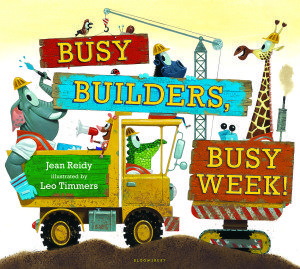
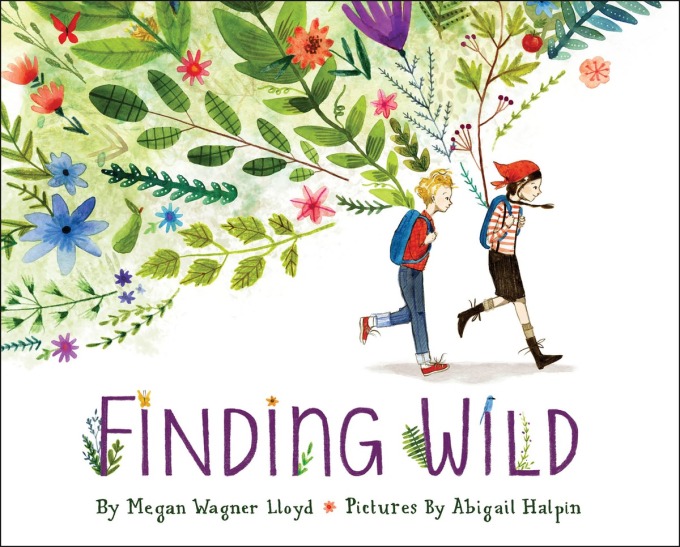 From the moment I saw the cover of FINDING WILD, I knew I needed to learn more about the inspirations and dreams for this beautiful book. I’m so pleased that Megan Wagner Lloyd agreed to give us a glimpse into just that!
From the moment I saw the cover of FINDING WILD, I knew I needed to learn more about the inspirations and dreams for this beautiful book. I’m so pleased that Megan Wagner Lloyd agreed to give us a glimpse into just that! Megan Wagner Lloyd has been reading for (almost) as long as she can remember, and writing stories for just as long. Her first picture book is FINDING WILD, illustrated by Abigail Halpin. She lives with her family in the Washington D.C. area.
Megan Wagner Lloyd has been reading for (almost) as long as she can remember, and writing stories for just as long. Her first picture book is FINDING WILD, illustrated by Abigail Halpin. She lives with her family in the Washington D.C. area.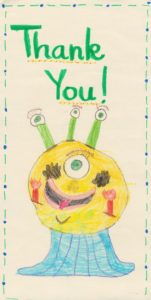 My Skype visit with first graders in Rhinelander, Wisconsin was one of my favorites of the year! And the happiness continued a week later when their lovely letters and art arrived in the mail. Thank you, students and teachers for such a warm and gracious “getting to know you.”
My Skype visit with first graders in Rhinelander, Wisconsin was one of my favorites of the year! And the happiness continued a week later when their lovely letters and art arrived in the mail. Thank you, students and teachers for such a warm and gracious “getting to know you.”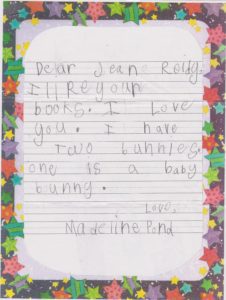
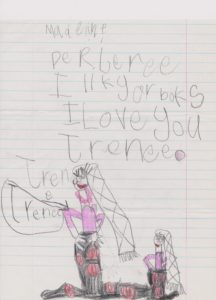
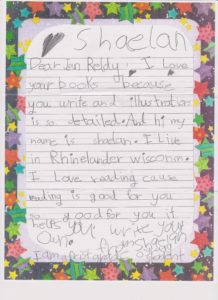
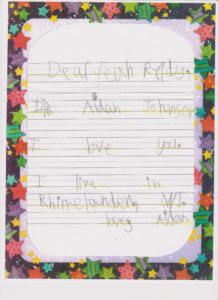


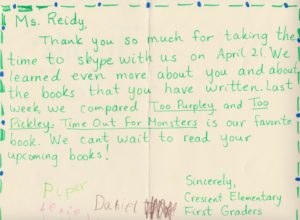
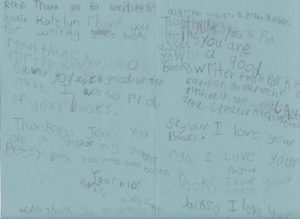
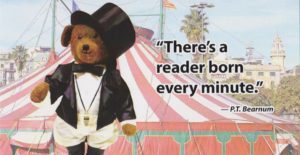
 Here’s the announcement from Publishers Marketplace:
Here’s the announcement from Publishers Marketplace: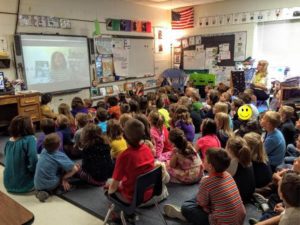 Ellie Rumney is a library media specialist extraordinaire from Rhinelander, Wisconsin. Her heartfelt post gave me goosebumps. Yes, small moments can provide endless inspiration. Thank you, Ellie!
Ellie Rumney is a library media specialist extraordinaire from Rhinelander, Wisconsin. Her heartfelt post gave me goosebumps. Yes, small moments can provide endless inspiration. Thank you, Ellie! Reading and literacy are vital elements of our children’s education, and students are immersed in materials that allow them to embrace the world of words around them. Much of the time, authors are an abstract name connected to books the students are enjoying. Allowing students to meet and connect a face to a name through an author visit both in person or via internet teleconference is a vital connection between the abstract and the concrete. When students can connect the name to a face, they can understand that it is a real person behind a published piece of work. This in turn inspires students to be readers and writers, as they can understand that the people behind the work aren’t magicians and writing isn’t an impossible task. As students meet authors, they can hear the author’s voice in the piece of literature they are reading and connect the story to a part of that author’s life. They are inspired to write after hearing an author talk about the process of writing and how it begins small for even the most accomplished authors.
Reading and literacy are vital elements of our children’s education, and students are immersed in materials that allow them to embrace the world of words around them. Much of the time, authors are an abstract name connected to books the students are enjoying. Allowing students to meet and connect a face to a name through an author visit both in person or via internet teleconference is a vital connection between the abstract and the concrete. When students can connect the name to a face, they can understand that it is a real person behind a published piece of work. This in turn inspires students to be readers and writers, as they can understand that the people behind the work aren’t magicians and writing isn’t an impossible task. As students meet authors, they can hear the author’s voice in the piece of literature they are reading and connect the story to a part of that author’s life. They are inspired to write after hearing an author talk about the process of writing and how it begins small for even the most accomplished authors.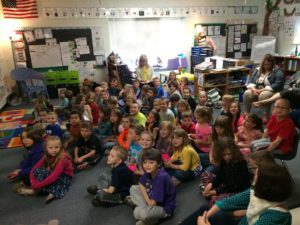 After meeting Jean Reidy, teachers talked to their students about making connections and writing about their own small moments. One teacher said, “As writers, we want to emphasize the students writing about small details in their stories. Jean Reidy’s Time Out For Monsters is about her childhood experience of being in a time out.” Hearing a published author share her inspiration for writing a story about a small moment in her life has allowed the students to see that writing is not as scary or intimidating as they may feel or think it is. Connecting to the small moments that authors use for inspiration makes reading and writing more accessible to students.
After meeting Jean Reidy, teachers talked to their students about making connections and writing about their own small moments. One teacher said, “As writers, we want to emphasize the students writing about small details in their stories. Jean Reidy’s Time Out For Monsters is about her childhood experience of being in a time out.” Hearing a published author share her inspiration for writing a story about a small moment in her life has allowed the students to see that writing is not as scary or intimidating as they may feel or think it is. Connecting to the small moments that authors use for inspiration makes reading and writing more accessible to students.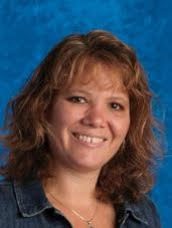 Ellie Rumney taught for 12 years before becoming a Library Media Specialist for the School District of Rhinelander. As a teacher, she was passionate about integrating technology and 21st Century Skills into her classroom. Her journey to become an LMS gave her access to an amazing learning network of professionals that she relies on in the current educational climate. As a Library Media Specialist, she continues to share her enthusiasm for 21st Century learning and information literacy with teachers and students in the classrooms and libraries.
Ellie Rumney taught for 12 years before becoming a Library Media Specialist for the School District of Rhinelander. As a teacher, she was passionate about integrating technology and 21st Century Skills into her classroom. Her journey to become an LMS gave her access to an amazing learning network of professionals that she relies on in the current educational climate. As a Library Media Specialist, she continues to share her enthusiasm for 21st Century learning and information literacy with teachers and students in the classrooms and libraries. When I was a child, I loved reading poetry. But later in life when I learned to analyze and deconstruct poems, my passion faded. Poetry can be hard to decipher. And when you try too hard, the deciphering can bog you down.
When I was a child, I loved reading poetry. But later in life when I learned to analyze and deconstruct poems, my passion faded. Poetry can be hard to decipher. And when you try too hard, the deciphering can bog you down.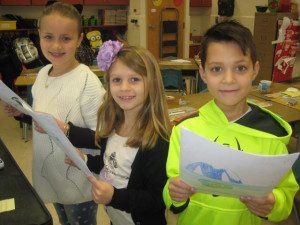
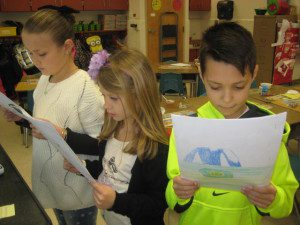 nts made comparisons between her stories, tied in stories that were similar to Jean’s, shared real-life connections, and made Jean feel like a “Super Star” with their letters of adoration.
nts made comparisons between her stories, tied in stories that were similar to Jean’s, shared real-life connections, and made Jean feel like a “Super Star” with their letters of adoration. Author, Jenny Goebel, will tell you she’s led a charmed life. But when you get to know her, you quickly understand her life has little to do with luck and everything to do with Jenny. She’s sweet, kind, caring and – most of all – talented. Today she’s talking about world building and her latest novel FORTUNE FALLS. No doubt, her readers are the lucky ones – I’m sure you’ll agree! Take it away, Jenny!
Author, Jenny Goebel, will tell you she’s led a charmed life. But when you get to know her, you quickly understand her life has little to do with luck and everything to do with Jenny. She’s sweet, kind, caring and – most of all – talented. Today she’s talking about world building and her latest novel FORTUNE FALLS. No doubt, her readers are the lucky ones – I’m sure you’ll agree! Take it away, Jenny! loring what impact all of this would have on Sadie’s character was the final, fundamental aspect of making this outlandish tale seem possible. Knowing that fate wasn’t on her side, it seemed unlikely that Sadie would be bold and reckless. But I couldn’t have her be too disparaged either, or it wouldn’t be believable that she was resilient enough to overcome the obstacles before her. It was clear she needed places in her life where she could find redemption. This redemption comes for Sadie in the form of friendship and learning to rely on her own cleverness and aptitude to see her way through some very bleak times.
loring what impact all of this would have on Sadie’s character was the final, fundamental aspect of making this outlandish tale seem possible. Knowing that fate wasn’t on her side, it seemed unlikely that Sadie would be bold and reckless. But I couldn’t have her be too disparaged either, or it wouldn’t be believable that she was resilient enough to overcome the obstacles before her. It was clear she needed places in her life where she could find redemption. This redemption comes for Sadie in the form of friendship and learning to rely on her own cleverness and aptitude to see her way through some very bleak times. Last month I had the great honor of a virtual visit in the classroom of one of New Jersey’s finest teachers, Kevin McCann. Kevin brings out the best in kids. It shows in his amazing students, and – as you’ll see below – in his adorable sons. I know you’ll enjoy this peek into our visit as well as a glimpse into the family life of one great dad!
Last month I had the great honor of a virtual visit in the classroom of one of New Jersey’s finest teachers, Kevin McCann. Kevin brings out the best in kids. It shows in his amazing students, and – as you’ll see below – in his adorable sons. I know you’ll enjoy this peek into our visit as well as a glimpse into the family life of one great dad!  It is funny how ideas can come to you when you are a teacher. I am not only a third grade teacher at John F. Kennedy Elementary School in South Plainfield, New Jersey, I am also a proud parent of three awesome boys. They challenge and push my wife and me everyday. Each in their own way! My oldest son, Daniel, has a strong personality. The youngest, Tyler, is going through the stage of not sharing. My middle son, Matthew, is the one who fusses about food.He would eat mozzarella sticks or chicken nuggets everyday of the week if allowed. It’s ironic because he won’t try a breaded chicken cutlet because he says, “I don’t like that kind of chicken.”
It is funny how ideas can come to you when you are a teacher. I am not only a third grade teacher at John F. Kennedy Elementary School in South Plainfield, New Jersey, I am also a proud parent of three awesome boys. They challenge and push my wife and me everyday. Each in their own way! My oldest son, Daniel, has a strong personality. The youngest, Tyler, is going through the stage of not sharing. My middle son, Matthew, is the one who fusses about food.He would eat mozzarella sticks or chicken nuggets everyday of the week if allowed. It’s ironic because he won’t try a breaded chicken cutlet because he says, “I don’t like that kind of chicken.” My wonderful wife, Michelle, who is also a fabulous teacher, was aware of a book to read to the boys, which might encourage Matthew to try other foods. The book was Too Pickley by Jean Reidy. Coincidentally, during writing workshop that day, my class was talking about being more descriptive with their word choices. When I heard Jean Reidy’s choice of words, I knew it would be perfect for my class. I always love when a picture book can be used in the classroom to model or enhance a concept or skill. For instance, I have used If You Give A Pig A Pancake by Laura Numeroff to help with cause and effect. The books I Wanna Iguana and I Wanna New Room by Karen Kaufman Orloff have been used to help teach persuasive writing. Was this another picture book I could use to help the class? Time would tell!
My wonderful wife, Michelle, who is also a fabulous teacher, was aware of a book to read to the boys, which might encourage Matthew to try other foods. The book was Too Pickley by Jean Reidy. Coincidentally, during writing workshop that day, my class was talking about being more descriptive with their word choices. When I heard Jean Reidy’s choice of words, I knew it would be perfect for my class. I always love when a picture book can be used in the classroom to model or enhance a concept or skill. For instance, I have used If You Give A Pig A Pancake by Laura Numeroff to help with cause and effect. The books I Wanna Iguana and I Wanna New Room by Karen Kaufman Orloff have been used to help teach persuasive writing. Was this another picture book I could use to help the class? Time would tell!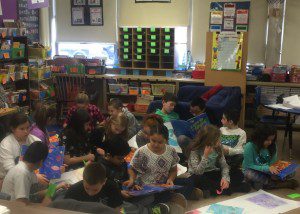 The next day I read Too Pickley to my class. The students loved the book. It wasn’t only the rhyming and descriptive use of words, but the magnificent illustrations that made the class ask to read it again. I decided to go to the library and get Too Purpley and Too Princessy. Our class was also working on generating ideas for writing while enhancing their word choice. The books in this series were perfect picture books to use in the class to help the students understand these skills, Jean Reidy does an outstanding job with her word choices. As a class, we then looked at the background information on each book as we explored her website. We were trying to see if we could find out where Jean Reidy generated the ideas for her books. We discovered the books were about people she knew…the people in her life! This is a conversation that is continuously woven throughout our writing workshops as students are working to find inspiration for their own writing ideas. Her books made everything real for my students. They understood that they could look to the people in their lives for story ideas.
The next day I read Too Pickley to my class. The students loved the book. It wasn’t only the rhyming and descriptive use of words, but the magnificent illustrations that made the class ask to read it again. I decided to go to the library and get Too Purpley and Too Princessy. Our class was also working on generating ideas for writing while enhancing their word choice. The books in this series were perfect picture books to use in the class to help the students understand these skills, Jean Reidy does an outstanding job with her word choices. As a class, we then looked at the background information on each book as we explored her website. We were trying to see if we could find out where Jean Reidy generated the ideas for her books. We discovered the books were about people she knew…the people in her life! This is a conversation that is continuously woven throughout our writing workshops as students are working to find inspiration for their own writing ideas. Her books made everything real for my students. They understood that they could look to the people in their lives for story ideas.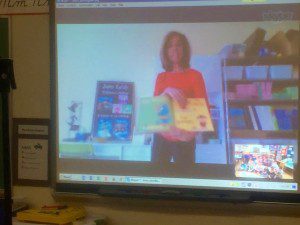 To cap it off, Jean Reidy made a virtual visit to our class through Skype. She discussed where she got her ideas for writing, read a book to the class, and even took time for questions. Matthew is still “too pickley,” but thanks to him, my class was able to use Jean Reidy’s books in class, meet Ms. Reidy, and enhance our knowledge of writing through real life experiences!
To cap it off, Jean Reidy made a virtual visit to our class through Skype. She discussed where she got her ideas for writing, read a book to the class, and even took time for questions. Matthew is still “too pickley,” but thanks to him, my class was able to use Jean Reidy’s books in class, meet Ms. Reidy, and enhance our knowledge of writing through real life experiences!
